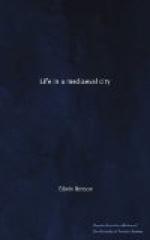FOOTNOTES:
[1] G. Benson: “Parish of Holy Trinity, Goodramgate, York.”
[2] De heretico comburendo, 1401. In 1539 Valentine Freez, a freeman, and his wife, were burnt at the stake on Knavesmire for heresy. Frederick Freez, Valentine’s father, was a book-printer and a freeman (1497).
[3] Cf. French journee.
[4] Sauce was much used. The people of the Middle Ages had an especial liking for spices and highly-seasoned foods.
[5] As translated from the Latin by the late Mr. R.B. Cook and found among his valuable contributions to the publications of The Yorkshire Architectural Society.
CHAPTER V
CONCLUSION
Life in York in the fifteenth century was active. Trade, home and continental, was flourishing. Building operations were in hand; work was always proceeding at the Minster or at one or other of the religious houses and churches. There were so many social elements established in and visiting York that something of interest was always taking place. Entertainments were plentiful and pageants were as well produced in York as anywhere in the kingdom. The city enjoyed a particularly large measure of local government. Its reputation was great. According to contemporary standards it was a fine prosperous city, one that contained resplendent ecclesiastical buildings that were second to none. In short, it was a “full nobill cite.”
Although the present city looks, in parts, more typically mediaeval than modern, York to-day forms a very great contrast with the fifteenth-century city. We are separated from the fifteenth century by the Renaissance, the Reformation, and Tudor England, by the Civil War and the Restoration, by the “age of prose and reason,” the keen-minded and rough-mannered eighteenth century, by the Industrial Revolution, and by that second Renaissance, the Victorian Age, during which the amenities of daily life were revolutionised. Radical changes are to be seen, for example, in the style of architecture, the mode of transmission of news, the methods of transport, the form of municipal government, the maintenance of the public peace, and in social relationships, more particularly with regard to industry and commerce and the parts played by employer and employed. The number of inhabitants to-day is about six times that of the mediaeval city. The contrast, which is so great in most ways as to be quite obvious, is an interesting and profitable study, but it might have been founded on more precise data, for, great as is the amount of valuable material that York can supply concerning its history, investigation shows how much greater that amount would have been had the city and its rulers during the last century or two realised the value of the accumulated original historical riches that it contained.




